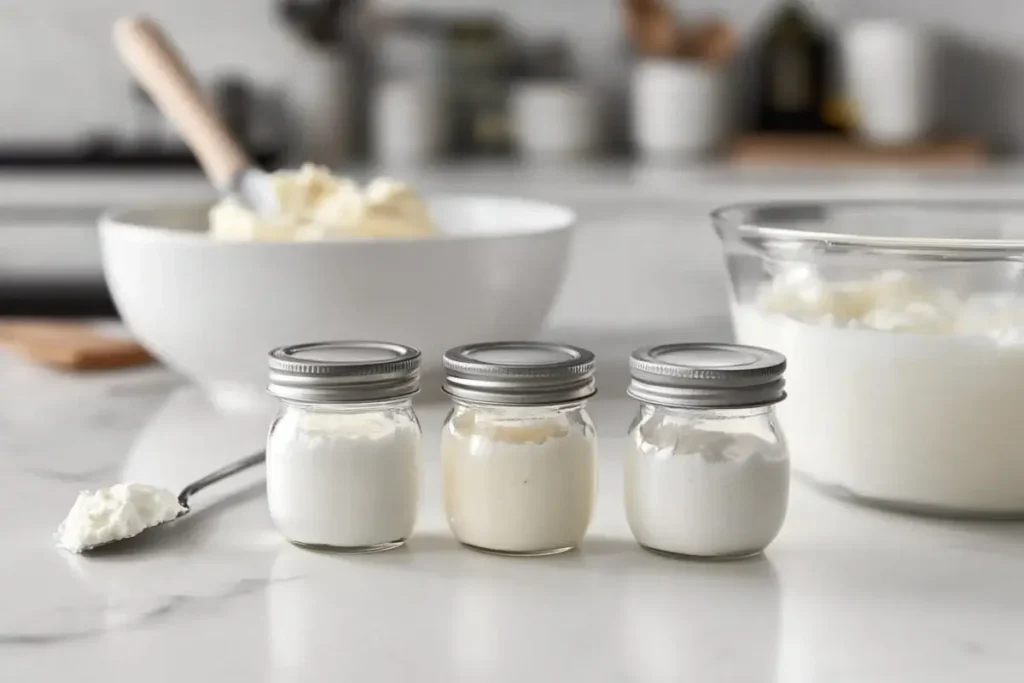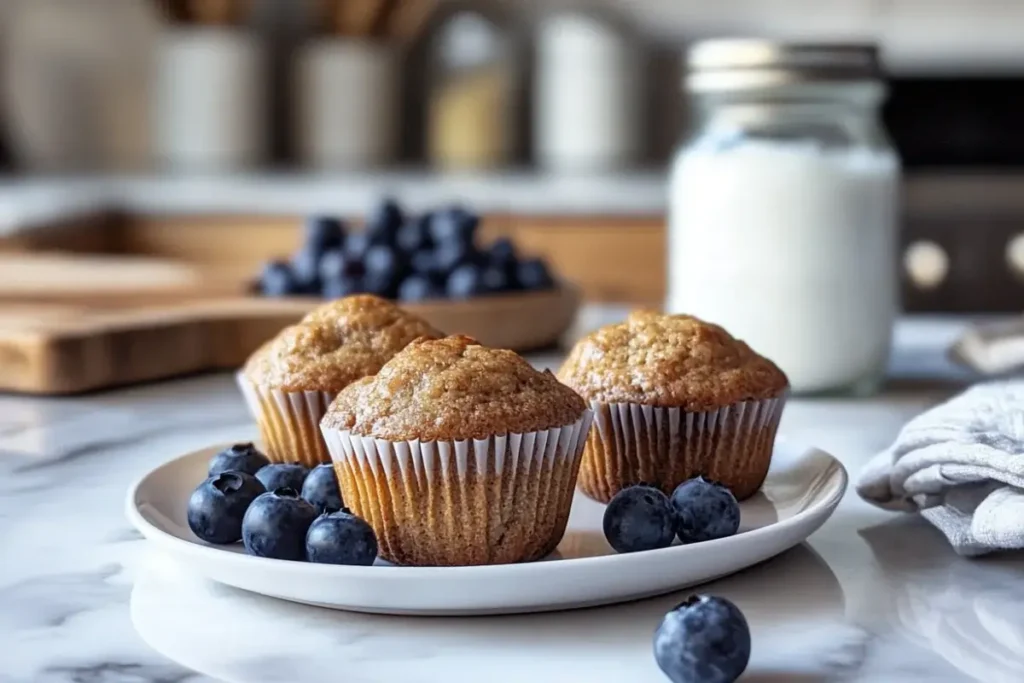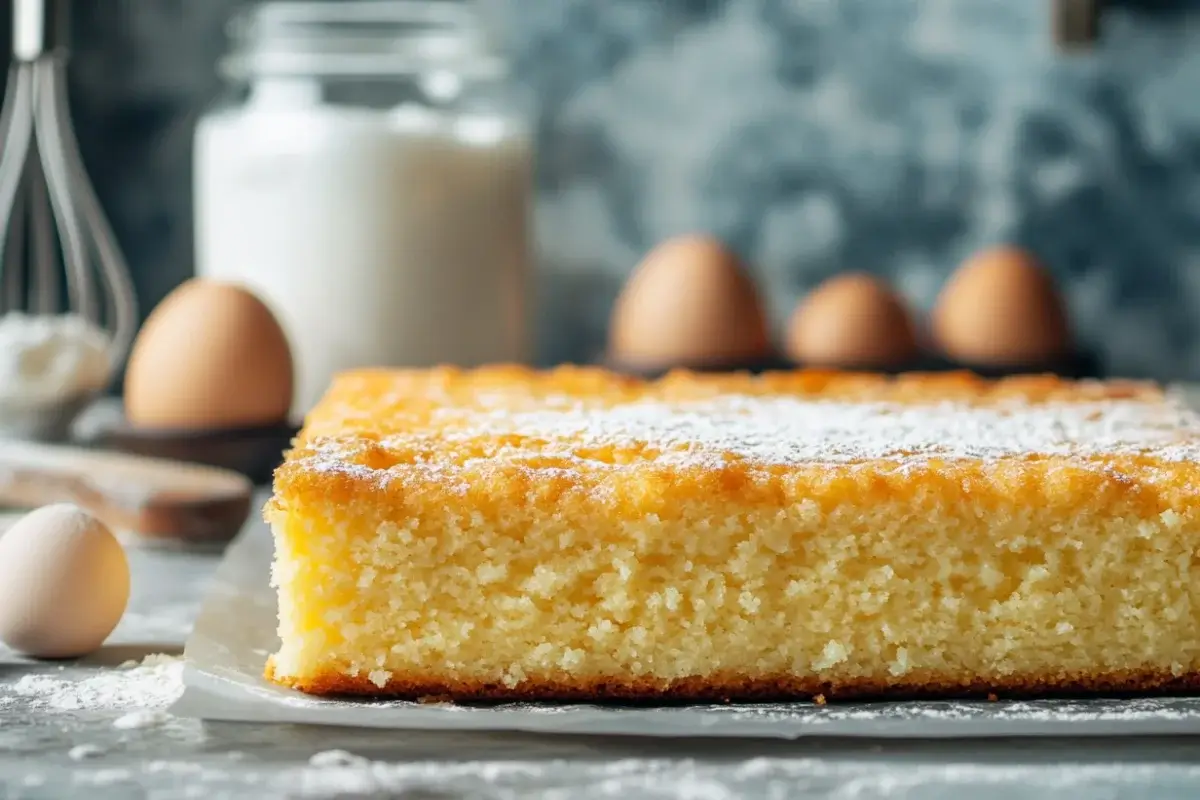Last Updated on May 9, 2025 by Souhail
Curious about the use of kefir in baking? This tangy, probiotic-rich ingredient isn’t just for smoothies, it’s actually a secret weapon for ultra-moist, tender, and flavorful baked goods. Whether you’re swapping it in for buttermilk, yogurt, or milk, kefir adds a subtle tang and boosts the rise in everything from pancakes to quick breads.
Thanks to its natural acidity and creamy texture, kefir works wonders in activating baking soda and enhancing the overall structure of your treats. Plus, it’s a great way to sneak in some gut-friendly probiotics! In this post, I’ll show you how to bake with kefir like a pro and share some tasty ideas to get you started.
Table of contents
- Why Use Kefir in Baking?
- Can I Use Kefir Instead of Yogurt in Cake?
- Can I Use Kefir Instead of Buttermilk in Cake?
- Can I Use Kefir Instead of Milk in Muffins?
- Other Recipes to Try with Kefir
- Benefits of Baking with Kefir
- Common Mistakes When Using Kefir in Baking
- Vegan Kefir Alternatives in Baking
- FAQ
- Final Thoughts
Why Use Kefir in Baking?
Before diving into specific substitutions, let’s take a moment to understand why kefir works so well in baking.
- Tangy Flavor: Kefir’s natural tanginess adds complexity to sweet recipes, balancing flavors beautifully.
- Moisture: Kefir is rich and creamy, ensuring baked goods stay moist without becoming heavy.
- Acidity: Its acidity interacts with baking soda or baking powder, helping cakes and muffins rise while creating a tender crumb.
- Nutritional Benefits: Packed with probiotics, vitamins, and minerals, kefir adds a touch of healthfulness to your recipes.
Can I Use Kefir Instead of Yogurt in Cake?

The short answer is yes! Kefir is an excellent substitute for yogurt in cakes, and in some cases, it may even enhance the final result.
How it Compares to Yogurt
Both kefir and yogurt are fermented dairy products with a tangy flavor, but there are some key differences:
- Consistency: Yogurt is thicker, especially Greek yogurt, while kefir has a pourable, milk-like consistency.
- Flavor: Kefir’s tanginess is similar to yogurt but can be slightly more pronounced.
- Nutritional Profile: Kefir typically contains more probiotics than yogurt, making it a great choice for gut health.
Using as a Yogurt Substitute
To substitute kefir for yogurt in cakes:
- Ratio: Use an equal amount of kefir as you would yogurt. For example, if the recipe calls for 1 cup of yogurt, replace it with 1 cup of kefir.
- Adjust Other Liquids: Since kefir is thinner than yogurt, you may need to slightly reduce other liquids in the recipe to maintain the right batter consistency.
Benefits of Using Kefir in Place of Yogurt
- The thinner consistency of kefir often makes mixing easier, ensuring a lump-free batter.
- Its tangy flavor can enhance the overall taste of the cake, especially when paired with sweet or fruity ingredients.
Recipe Idea: Easy Kefir Sheet Cake Recipe: Your New Go-To Dessert
If you’re curious about how kefir shines in cake recipes, try our Easy Kefir Sheet Cake Recipe: Your New Go-To Dessert. This delicious, moist, and tangy cake highlights the unique benefits of baking with kefir while offering a simple, beginner-friendly method. It’s a perfect example of how kefir can transform a classic dessert into something extraordinary.
Can I Use Kefir Instead of Buttermilk in Cake?
Kefir is one of the best substitutes for buttermilk, thanks to its acidity and similar tangy flavor.
How it Compares to Buttermilk
- Acidity: Both kefir and buttermilk are acidic, which means they perform the same role in recipes: activating leavening agents like baking soda or baking powder.
- Consistency: Buttermilk is slightly thinner than kefir, but the difference is negligible in most recipes.
Using Kefir as a Buttermilk Substitute
To replace buttermilk with kefir in cakes:
- Ratio: Use kefir as a 1:1 replacement for buttermilk. For example, if the recipe calls for ½ cup of buttermilk, use ½ cup of kefir.
- Whisking Option: If the kefir is too thick, whisk it lightly to loosen its texture before measuring.
Why Use it Instead of Buttermilk?
- It’s convenient kefir is often more readily available or already in your fridge.
- Kefir’s probiotic content makes it a healthier choice.
- Its slight thickness can add richness to the batter.
Recipe Idea: Kefir Chocolate Cake
Replace buttermilk with kefir in a classic chocolate cake recipe. The result is a moist, tender cake with a deep, rich flavor.
Can I Use Kefir Instead of Milk in Muffins?

Yes, you can substitute kefir for milk in muffins, and the results are often better than expected.
How it Compares to Milk
- Acidity: Unlike milk, kefir is acidic, which means it interacts with leavening agents in a way milk doesn’t. This can create a fluffier, softer texture.
- Flavor: Kefir’s tanginess adds depth to the flavor, complementing the sweetness of muffins.
- Consistency: Kefir is thicker than milk, which can slightly change the texture of the batter.
Using it as a Milk Substitute
To replace milk with kefir in muffins:
- Ratio: Use kefir as a 1:1 substitute for milk. For example, if the recipe calls for ¾ cup of milk, use ¾ cup of kefir.
- Leavening Adjustment: Since kefir is acidic, you may need to adjust the leavening agents. For example, if the recipe uses baking powder, consider adding a pinch of baking soda for better results.
Benefits of Using Kefir in Muffins
- Kefir creates a moist, tender crumb that milk can’t always achieve.
- It enhances the flavor, especially in fruity or spiced muffins.
Recipe Idea: Kefir Blueberry Muffins
Swap milk for kefir in a blueberry muffin recipe for an ultra-moist texture and a subtle tang that pairs perfectly with the sweetness of the berries.
Tips for Baking with Kefir
- Adjust for Acidity:
- Kefir’s acidity can affect leavening. If your recipe already uses baking soda, you’re good to go. If not, consider adding ¼ teaspoon of baking soda per cup of kefir.
- Thinning Kefir:
- If kefir feels too thick for a recipe, whisk it lightly or mix it with a splash of water before measuring.
- Pairing Flavors:
- Kefir’s tangy profile works well with citrus, berries, chocolate, and spices like cinnamon or nutmeg.
- Experiment with Fermentation:
- Kefir can add a sourdough-like depth to breads or pancakes when left to ferment slightly with flour overnight.
Other Recipes to Try with Kefir
- Kefir Pancakes: Replace milk with kefir for fluffy, tangy pancakes.
- Kefir Biscuits: Use kefir instead of buttermilk for tender, flaky biscuits.
- Kefir Banana Bread: Swap yogurt or milk for kefir in banana bread for an ultra-moist loaf.
Benefits of Baking with Kefir
Baking with kefir is not just a creative way to experiment with flavors; it also offers several practical and health-related benefits. Whether you’re a seasoned baker or a novice, incorporating kefir into your recipes can elevate your baked goods in surprising ways.
Health Benefits
Kefir is rich in probiotics, which are known to support gut health. While most probiotics are destroyed during baking due to high temperatures, the beneficial nutrients like calcium, B vitamins, and proteins remain intact. These nutrients contribute to the overall nutritional value of your cakes, muffins, and breads.
Improved Shelf Life
Kefir has a unique ability to keep baked goods moist for longer periods. The natural acidity and creaminess of kefir lock in moisture, preventing cakes and muffins from drying out. This means your baked treats stay fresh for days without needing preservatives.
Versatility in Recipes
From sweet treats like cakes and muffins to savory goods like biscuits and flatbreads, kefir’s tangy profile complements a wide variety of flavors. Its acidity also enhances the depth of flavor, making even simple recipes taste more complex and balanced.
Reduces Food Waste
Using kefir in baking is an excellent way to ensure leftover or older kefir doesn’t go to waste. Even if your kefir has passed its best-by date, it’s still perfectly usable in baked goods, making it a sustainable and economical choice.
Common Mistakes When Using Kefir in Baking
While kefir is an excellent ingredient for baking, there are a few common pitfalls to avoid when substituting it in recipes. These tips will help you achieve the best results every time.
Overcompensating for Tanginess
Kefir’s tangy flavor is one of its strengths, but too much acidity can overpower the sweetness in baked goods. To balance this, avoid adding other acidic ingredients, like vinegar or citrus juice, unless the recipe specifically calls for them.
Using Sweetened or Flavored Kefir
When baking, always opt for plain, unsweetened kefir. Flavored varieties often contain added sugars and artificial flavors that can throw off the balance of your recipe. For a more natural flavor, you can add your own fruit zest or extracts to the batter.
Neglecting Liquid Adjustments
Kefir’s consistency is different from that of yogurt, buttermilk, or milk. If the batter feels too thin, reduce the liquid content slightly by holding back on water, milk, or oil. Conversely, if the batter is too thick, a splash of water or a light whisking of the kefir can help.
Skipping Leavening Adjustments
Kefir’s acidity interacts with baking soda to help your baked goods rise. If your recipe doesn’t include baking soda, consider adding ¼ teaspoon per cup of kefir to ensure the proper rise and texture.
Vegan Kefir Alternatives in Baking
For those who follow a plant-based diet or have dietary restrictions, vegan kefir can be an excellent alternative to traditional dairy kefir. It offers the same tangy flavor and creamy consistency, making it just as effective in baking.
What is Vegan Kefir?
Vegan kefir is made by fermenting non-dairy milk options, such as almond milk, coconut milk, or soy milk, with kefir grains or a probiotic culture. The result is a tangy, slightly thickened beverage that mimics the qualities of traditional kefir.
Using Vegan Kefir in Baking
Vegan kefir can replace buttermilk, yogurt, or milk in the same way as dairy kefir:
- Ratio: Use a 1:1 substitution for yogurt, buttermilk, or milk in recipes.
- Flavor Adjustments: Since vegan kefir often has a milder tang than dairy kefir, consider adding a splash of lemon juice or apple cider vinegar to replicate the acidity.
Recipes Where Vegan Kefir Shines
Vegan kefir works beautifully in recipes like banana bread, muffins, and pancakes. Its tangy flavor and creamy consistency ensure moist, fluffy results, even without traditional dairy.
Where to Find Vegan Kefir
Many health food stores carry vegan kefir, or you can make your own at home by fermenting plant-based milk with a probiotic capsule or kefir grains. Homemade vegan kefir allows you to control the flavor and consistency, ensuring it’s perfect for your baking needs.
FAQ
Yes! Kefir can be used in non-dairy baking, especially when you opt for plant-based kefir. Vegan kefir made from almond, soy, or coconut milk works just as well as dairy kefir in recipes, providing the same tangy flavor and moisture.
While it’s true that the high temperatures of baking kill most probiotics in kefir, the other benefits of kefir remain. It still acts as an excellent tenderizer, adds moisture, and contributes to the flavor and texture of your baked goods. Plus, the vitamins, minerals, and proteins in kefir are retained during baking.
Kefir is thinner and tangier than sour cream or cream cheese, so while it can sometimes replace these ingredients, the results will vary. If you’re substituting kefir for sour cream or cream cheese, you may need to adjust the recipe’s liquid content or add a thickening agent.
Homemade kefir often has a more robust flavor and slightly thicker texture than store-bought versions. If you’re using homemade kefir, taste it first to gauge its tanginess and adjust your recipe accordingly. Store-bought kefir is typically more consistent in flavor and texture, making it a reliable choice for baking.
While kefir can’t replicate the richness of heavy cream in recipes like whipped cream, it can work as a lighter, tangier substitute in savory dishes or baked goods. For example, use kefir in a cake batter instead of heavy cream for a fluffier result.
Kefir brings unique benefits to baking that milk doesn’t. Its tangy flavor and acidity help enhance the flavor and texture of baked goods. While milk works well for neutral-tasting recipes, kefir adds depth and richness, making it a great choice for cakes, muffins, and pancakes.
Final Thoughts
Kefir is a baking secret weapon that offers a versatile and flavorful alternative to yogurt, buttermilk, and milk. Its tangy flavor, rich texture, and acidity make it a star ingredient in cakes, muffins, and more. Whether you’re improvising in the kitchen or looking to elevate your baked goods, kefir is a substitution worth trying.
Have fun experimenting with kefir in your recipes and discover how this probiotic-rich ingredient can transform your baking. Happy baking!

